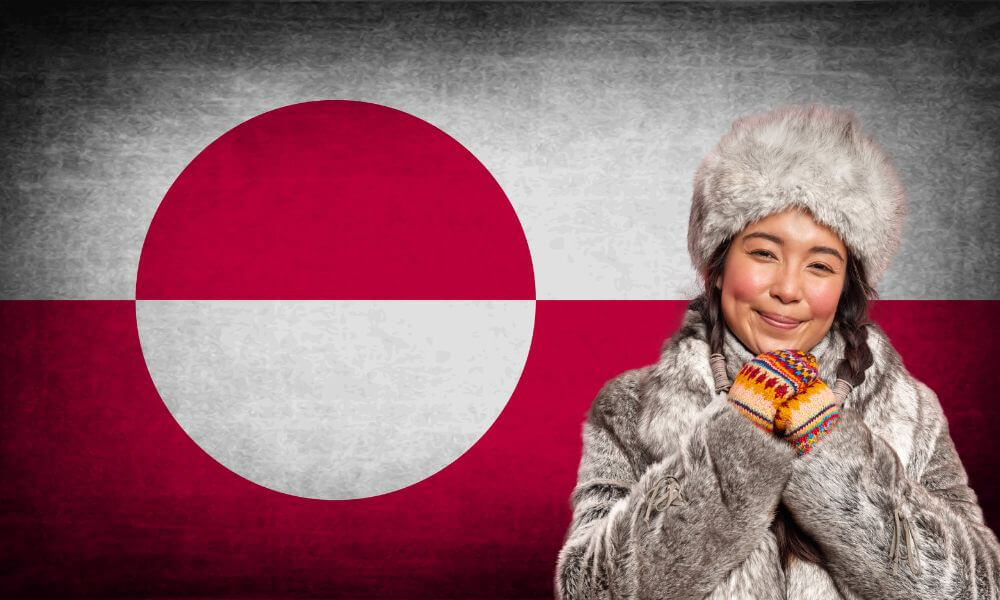The most common demonym for someone from Greenland is Greenlander, though the term Greenlandic is also used. However, the real answer is more complex; most Greenlanders are Inuit and identify themselves as such rather than as Greenlanders. There are also many Danish and other Nordic peoples living in Greenland.
Greenland is not itself a sovereign nation; it is a part of the Kingdom of Denmark.
Thus, from a legal standpoint, native Greenlanders are Danish in terms of citizenship.
Realistically, then, the simplest answer for what to call a person from Greenland is probably going to be Inuit—of course many are not, but “Greenlander” alone doesn’t tell us much about a person’s ethnicity or identity.

What is someone from Greenland called?
There are many ways to answer this question, but the easiest and most all-encompassing is simply Greenlander.
This is a term for a person who lives in Greenland, whether they have always lived there, immigrated there, or even live elsewhere and have Greenlander ancestry.
But the truth is a great deal more complex than this, and there are two basic reasons why.
The first and most important is that around 89% of Greenland’s population today is made up of indigenous Inuit people.
This figure includes multi-ethnic Europeans who have mixed with the Inuit in the past, mostly Danish people.
So, from the point of view of the people who live there, you would mostly call them Inuit—they themselves would recognize Greenland as a European term.
The land mass of Greenland is not in itself a sovereign nation.
It is an island country that is part of the Kingdom of Denmark, so from a legal point of view, the people of Greenland are Danish.
Again, though, most probably would not think of themselves in this way and the indigenous Inuit certainly would not.
That said, around 7.5% of Greenland’s present population is of Danish descent or ancestry.
These people likely would think of themselves as Danish in all senses of the word, though they have become a Greenlander in some sense.
So, from the point of view of both the vast majority of the population and the legal standing of its citizens, Greenlander really is not the best term for someone from Greenland.
That said, it remains a useful term to encompass all people who may happen to live in Greenland, whether they be indigenous Inuit or Danish or even other Nordic identities.
Where does the name “Greenland” come from?
It is often seen as particularly confounding that Iceland, the green country with admittedly lots of Ice, and Greenland, the icy country with fair amounts of green, seem to have had their names switched.
Greenland has been inhabited to some extent by Norse people for well over a thousand years, and the traditional story goes that the land was originally called Groenland in Old Norse by its discoverer, around 986 CE, in order to induce people to travel and settle there.
Greenland is far from inhospitable, but at the same time the natives live a life that’s hard for many of us to truly imagine.
They have adapted to the bitter cold but nonetheless it makes life a struggle.
Norse settlers, then, discovering the island, wanted to induce people to come so that there would be a greater community and thus a better chance of establishing a successful colony and settlement.
So, all of the jokes about Greenland and Iceland are perfectly understandable—it was all a ruse to try and convince hapless Nordic people to leave their comfortable shores for a promised green land.
What language do Greenlanders speak?
Greenland does indeed have its own official language: Greenlandic.
This was made the official language in 2009 to combat the spread of Danish in the country.
Greenlandic has about 57,000 speakers today, and is the language used by the Greenlandic Inuit in Greenland.
It is part of what is still called the Eskimo-Aleut language family, though more on this term “Eskimo” shortly.
It is very closely related to the other Inuit languages in Canada, and the main variety of the language is called Kalaallisut, meaning West Greenlandic.
It is even recognized as an official minority language in Denmark itself.
Danish and even languages are also recognized by Greenland’s autonomous government.
Are Inuit and Eskimo the same?
The simple answer is no, they are not the same.
In general, it’s really important that you avoid using the word Eskimo.
Though it is still used today as a classifier for certain aspects of Inuit culture, like language, it is a term with a great deal of historical baggage.
It was in the past actively used as a slur and meant to be derogatory and offensive, a term used by colonial powers of the local tribes.
Inuit is the accepted term today, and though Inuit still encompasses a great many disparate cultures, there is no historical baggage.
Inuit and Eskimo are not the same, whether or not you still find the word Eskimo in certain places here and there.
So, if there’s on crucial piece of advice I could give you, it’s don’t call anyone an Eskimo.
It is at best an inaccurate term and at worse a racist slur.
The people of Greenland are mostly Inuit, and they are indigenous folk that have been living in the area for thousands of years.
At the same time, in the modern sense of the nation-state, everyone in Greenland is Danish and a citizen of Denmark.
More in Demonyms
- What Do You Call Someone From Afghanistan?
- What Do You Call Someone From Algeria?
- What Do You Call Someone From Argentina?
- What Do You Call Someone From Australia?
- What Do You Call Someone From Azerbaijan?
- What Do You Call Someone From Bangladesh?
- What Do You Call Someone From Barbados?
- What Do You Call Someone From Belgium?
- What Do You Call Someone From Botswana?
- What Do You Call Someone From Crete?
- What Do You Call Someone From Denmark?
- What Do You Call Someone From Ecuador?
- What Do You Call Someone From Egypt?
- What Do You Call Someone From El Salvador?
- What Do You Call Someone From Fiji?
- What Do You Call Someone From Finland?
- What Do You Call Someone From France?
- What Do You Call Someone From Ghana?
- What Do You Call Someone From Greece?
- What Do You Call Someone From Greenland?
- What Do You Call Someone From Hong Kong?
- What Do You Call Someone From Iceland?
- What Do You Call Someone From India?
- What Do You Call Someone From Ireland?
- What Do You Call Someone From Israel?
- What Do You Call Someone From Japan?
- What Do You Call Someone From Jersey?
- What Do You Call Someone From Jerusalem?
- What Do You Call Someone From Jordan?
- What Do You Call Someone From Kazakhstan?
- What Do You Call Someone From Laos?
- What Do You Call Someone From Malta?
- What Do You Call Someone From Myanmar?
- What Do You Call Someone From Niger?
- What Do You Call Someone From Pakistan?
- What Do You Call Someone From Panama?
- What Do You Call Someone From Peru?
- What Do You Call Someone From Rwanda?
- What Do You Call Someone From Singapore?
- What Do You Call Someone From Sri Lanka?
- What Do You Call Someone From Sweden?
- What Do You Call Someone From Switzerland?
- What Do You Call Someone From Thailand?
- What Do You Call Someone From The Isle of Wight?
- What Do You Call Someone From The Ivory Coast?
- What Do You Call Someone From The Netherlands?
- What Do You Call Someone From Uzbekistan?
- What Do You Call Someone From Vatican City?
- What Do You Call Someone From Wales?
- What Do You Call Someone From Zimbabwe?

